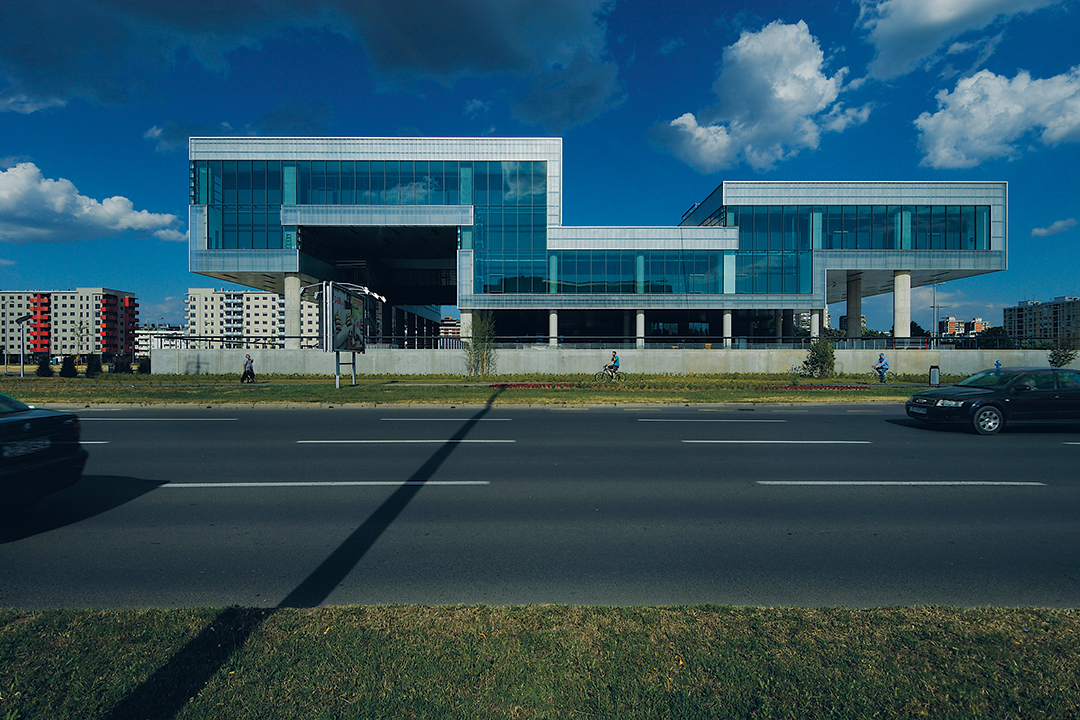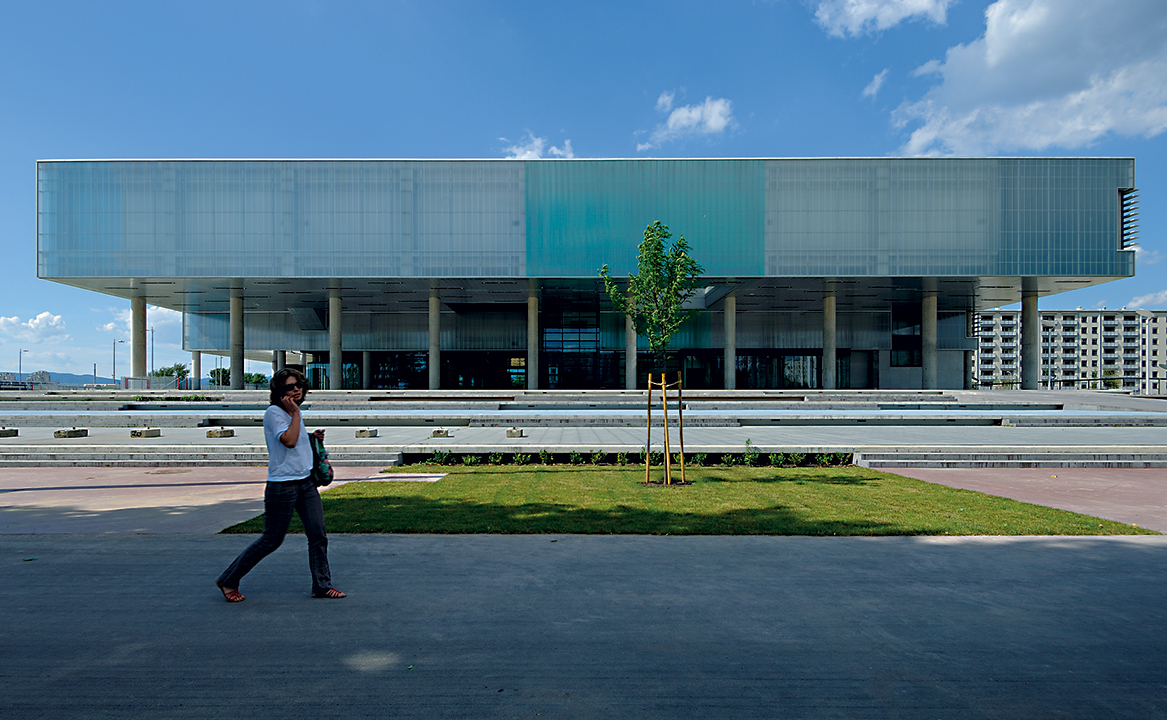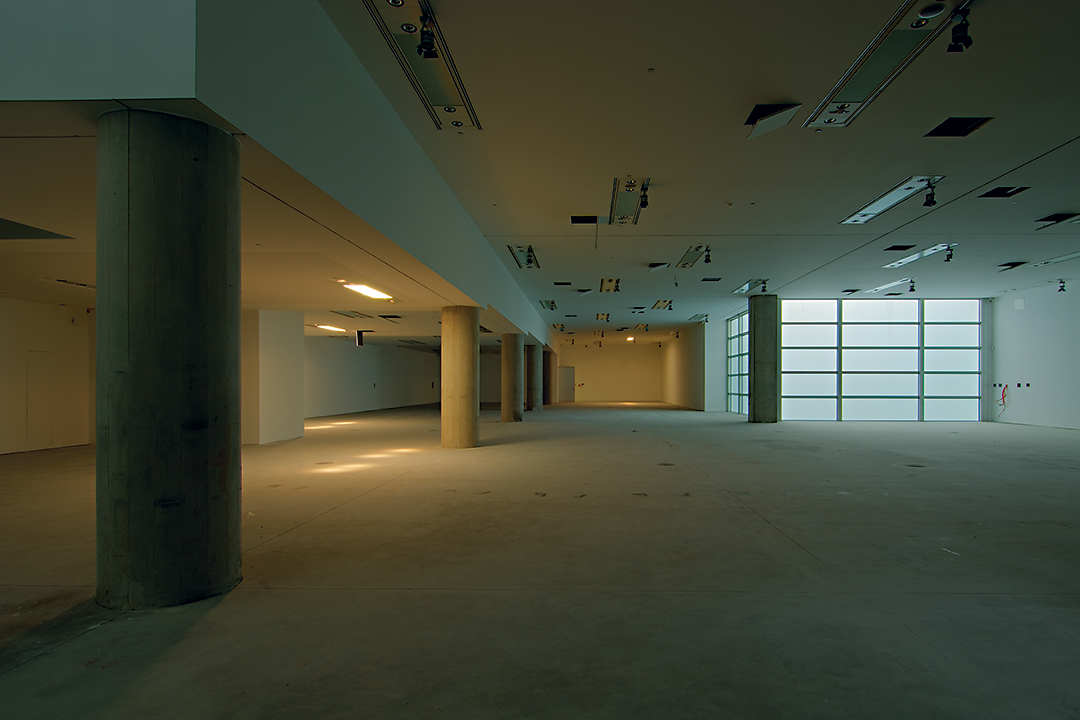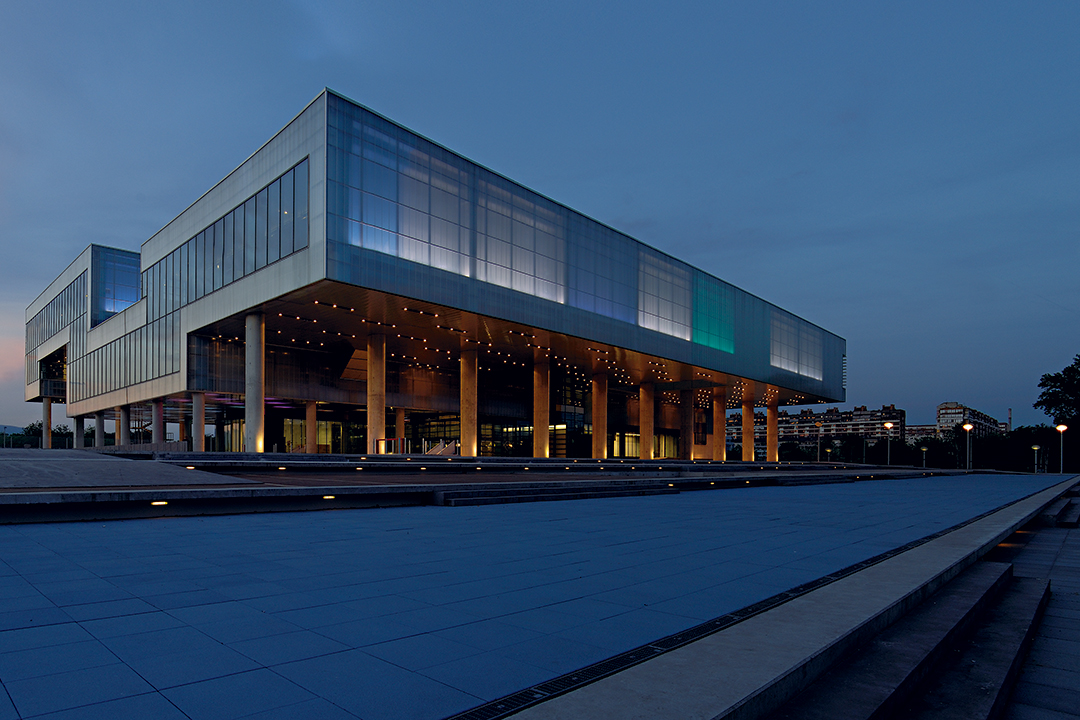After almost ten years of the ongoing construction of the Museum of Contemporary Art in Zagreb, the works have not yet been completely finished, nor is the moment when the building will be open to the public known. Nevertheless, despite this typical Croatian situation, doubts about the Museum of Contemporary Art have existed for decades, from the question of the choice of location to the comments about the project by Igor Franić, who was the winner of the public competition held in 1999. The long duration of realization and observation of the slowly emerging new building certainly affects the perception of the very project as well because, whether we want it or not, we are gradually getting used to its architecture and to the place where it is emerging. We have witnessed various phases of the project’s growth, which was criticized and is still criticized in the lobbies: from the surprisingly corpulent and robust concrete skeleton which looked excessively large and sturdy, to the ‘insincere’ procedure of stretching polycarbonate membrane over walls, to the appearance of ‘cages’ on the roof which hide technical facilities in rather compact volumes. The very construction of the building could raise a certain uncertainty and moments of intellectual doubt among advocates of the project; however, the current phase in which almost all architectural elements of the building have been completed shows that this is a unique building which is authentic in a conceptual sense and which undoubtedly belongs to the Croatian architectural cultural circle.
The controversy over what is a contemporary museum of art could be endless and without a way out, like a Borgesian labyrinth. Colin Fournier, the author of the Kunsthaus (with Peter Cook) in Graz admitted to the author of this text without restrain that there is an enormous dilemma of whether one should participate at all in competitions for buildings of museums of visual arts. He considered this as out of date and unnecessary back at the beginning of the seventies, and therefore refused an invitation by Richard Rogers to participate in the competition for the Pompidou Centre. Nevertheless, Graz is not the same thing as imperial Paris and in Zagreb and Croatia, not one building for exhibiting the visual arts has been built since the completion of the Meštrović Pavilion, with exception of Emili’s rather small purple masterpiece on Gradec, which has been partly demolished and left to deteriorate. Use of Zagreb Fair pavilions for artistic exhibitions has already shown that Zagreb is in need of a museum of contemporary art, regardless of experiences like, for example, the ‘new artistic practices’, Podroom, and the fact that many of the most exciting achievements on the Croatian artistic scene have today been occurring outside big institutions and within independent curatorial practices.

Is it possible to turn a delay of several decades into an advantage and use the experience of contemporariness in the concept of museum building? What should this building look like? Iconic architecture or a neutral space which retreats from the art? In its own way, Franić’s project is both, and all the arguments pro and contra can be reduced in the general perception to a question of good taste which is allegedly not to be discussed. However, Krleža established that what is clever cannot be ugly, and this simple axiom can be applied to architecture. It is fairly certain that Kenneth Frampton, in his claim that Croatian architecture oscillates between ‘monumentality and dematerialization’, paid most attention precisely to the contemplation about Franić’s project. He concluded that the project could be the ‘best contemporary Croatian building in Zagreb’ when completed, by this implying the design approach from which this building resulted. It should be said that, as much as the project is Franić’s original work, it is equally clearly based on (neo-) modernist principles according to which an architectural concept is solved through coordination of a geometrically precise spatial idea and as rational as possible a technical and structural solution. In such an approach, form is the consequence of spatial ideas, and invention occurs through inventiveness of translating the programme into spatial interrelations. Everything that is not a clear consequence of this interrelation of programme and space is considered redundant. Franić’s building is, in this sense, up to date, the biggest and most ambitious exhibit of the polytechnic doctrine of a group of authors gathered around the epicentre of ‘the fifth floor’[1] at the Faculty of Architecture in Zagreb and it should be considered a rather credible realization of the programmatic propositions of the middle generation of Croatian architects, formed in an authorial sense during the 1980s and 1990s and dedicated to designing, but little to constructing.
The museum’s location was chosen on the intersection of Većeslav Holjevac Avenue and Dubrovačka Avenue, in an area where the original town plan of Novi Zagreb foresaw a cultural centre in the form of a continuing mega-structure which was an extension of the Fair. This, previously entirely desolate, intersection has gradually been constructed; however, the width of the streets is rather large, therefore this area will never become a space with a more clearly defined urban physiognomy, and each of the four plots located around the intersection represent isolated boxes which are not and cannot be connected under any circumstances. The space north of the museum was intended for cultural content in the past, but construction of a hybrid business-commercial-residential complex started, which was outside the logic of installing public contents along the north-south axis. Also, there is an ongoing construction of entirely pointless, in terms of town planning, and architecturally incredibly banal residential blocks north-east of the museum, which provides a tasteless image. The decision of the choice of ‘urban’ place for the museum is therefore less and less logical, and probably a happier solution would have been to move the museum further to the north, nearer the Sava, where the important cultural programme could be articulated as part of the river zone, perceived as a park with public content. In such an environment which, at the time of the competition, did not have any urban features except for its belonging to the Novi Zagreb matrix, Franić generates his own urbanism within the boundaries of the plot and forms a spatial square which rises slightly towards the huge ‘hovering’ volume of the museum thus spreading over the public space. The relation between the huge, practically neo-classicistic porch and access cascades evokes Schinkel’s Altes Museum in Berlin and is scenery of metropolitan scale and public space with which no other Zagreb urban situation can be compared in terms of impressiveness. Namely, this is scenery in which the relation between architectural and urbanistic articulation and the symbolic meaning of a public cultural institution is clear. The monumental dimensions of the colonnade are in harmonious proportion with the scale of the building, but with the wider context as well, while the building’s volume which protrudes over the porch contributes to the dramatic impression. The entire ground floor is loose and worked out as an extension of the square on which the main entrance, restaurant and bookshop are situated. The glass membrane of the ground floor is not unified, but indented and indicates the presence of different contents. The entrance area with huge info stand and space for smaller exhibitions is of modest dimensions, anti-monumental and without particular spatial attractions. There is merely an indication of two routes of movement towards the permanent and temporary displays which are marked in space with flights of stairs, not too luxuriously dimensioned. This is undoubtedly only preparation and part of a scenario of suspense of movement and of spatial experience before entering the exhibition halls. After all, we are still under the museum.

Franić forms the body of the building as a geometrically very simple solid of approximately square layout with a cross section in the form of a meander. Sequences of exhibition space result directly from the ‘broken’ cross section, therefore the museum develops through linear stretches perpendicular to the lateral, meandering profile of the building. Consequently, the basic direction of the space is defined through a sequence of parallel x-axes in relation to the entrance porch, during which process their format changes through progression, in other words translation of the floor and ceiling within y-coordinates. These stretches are of different heights and in different interrelations, and terraces or space under the building body flow between them, so the exterior and interior spatial segments alternate along the y-axis. The building body is perforated by three vertical penetrations, of which two are ‘hovering atriums’, with their soffits also visible from under the building, while one light well descends along the entire height of the building all the way to the basement floor. This spatial articulation is simple in its basic geometrical scheme, always of the same length along the x-axis and fixed through the matrix of the entirely consistent structural system within a square grid. Despite the clear Euclidean geometry, manipulation of x-y-z axes is not based in its essence on a logical or immediately readable spatial system, but is rather a sequencing of specific situations and varying of the relations inside-outside, up-down, wall-transparency-translucence. In this progression, the first experience and attempt to understand the building’s spatial concepts leave a somewhat arbitrary impression, as if it is a series of separately created sequences which obviously resulted from a series of interrelated geometrical operations and the same module, but the notion of an idea of the whole is absent. This impression will change to a certain degree when the museum receives its exhibits; however, the fact is that the museum does not have a spatial focus, but is meant as a spatial equation which is non-hierarchical, as much as it has no fixed or entirely readable course. Namely, movement through the museum can be achieved via different routes, therefore the two main massive concrete staircases – one which leads to the permanent, and the other to the temporary display – are supplemented with an ‘auxiliary’ steel staircase and escalator in the temporary exhibitions area. There is an assumption that such an organization will motivate visitors to explore exhibitions more independently and actively, and to find their own routes through different periods and media.
Unexpectedly, light is not let into the interior from the lateral sides of the meander, but through horizontal openings which run along the building body on the y-axis and vertical slits on the z-axis. Although the natural light is not zenithal, it always gets into the interior indirectly through interspaces, atria or highly placed slits and therefore the exhibition space is introvert and directed towards the exhibits. Nevertheless, the exterior space is not totally excluded from the complete experience, like for example, at the point of the connecting ‘bridge’, which joins the central and northern meander bends. Also, the roof terraces are accessible through two exterior staircases of grandiose dimensions which can also function as open auditoria.
The exhibition spaces are not articulated as a classical sequence of ‘white rooms’ (the frequently criticised conventional white cube) or as entirely open fluid space, but rather as a series of halls of different configurations and of rather large dimensions, which will require additional division into subspaces during display of the permanent exhibition.

The lateral sides of the meander are not intended for exhibitions, and so an informal ‘space for rest’ is anticipated in the western part, right next to a big glass wall, and is separated from the interior of the building by a partition. Here, visitors can ‘detach themselves’ from the art with a view of Većeslav Holjevac Avenue. The eastern part is, on the other hand, occupied with offices and other auxiliary facilities. Through the building’s core, however, two vertical blocks with autonomous regime of usage, not dependent on the functioning of the museum itself, rise like programmatic mini-towers: the block with restaurant that stretches from the ground floor through the first floor all the way up to the roof terrace, and the block with the library. The idea is that these contents could also be used outside the museum’s opening hours, which contributes to its porosity content-wise. These functional vertical ‘full’ blocks, together with the verticals of the lifts, are counterpoints to the vertical ‘empty’ penetrations of the light-well atria. The diversity of programmatic contents is added to by a spacious hall for lectures, presentations and performances which also has an independent exterior entrance.
The museum is characterized by design finesse on a micro-scale. The main staircases are double-flighted at the point of the gradual and intentionally slowed transition from the ground floor to the first floor, and then they continue into single-flight stairs in the direction of the main x-vectors of the exhibition spaces. The view of the entrance porch and square opens from the exhibition space only at the strategic place of the connection with access staircase. There are individual ‘traces’ of internal occurrences left on the exterior of the strictly defined body of the building, like soffits of the escalator or auxiliary staircase below the northern bend of the meander.
The relationship of the interior and exterior design shows a certain inversion of convention through the harshness of the interior and effectiveness of the exterior. The aesthetics of the interior is neutral and to a certain degree intentionally brutal. White walls, floors made of polished cement, and the unplastered concrete of the load-bearing structure all suggest that the museum building is primarily spatial infrastructure. On the other hand, all the meander’s body surfaces on all its sides are covered in polycarbonate sheets so the sub-construction is visible underneath. Polycarbonate consequently covers the ceiling of the ground floor interior unifying the hovering volume into an integral whole. White and green Lexan is combined, and surfaces behind the Lexan on the western façade are coloured blue, while they are coloured black on the eastern façade. Blue and black tones also spill over the southern façade edges, marking segments of the building’s cross section which correspond to the space for rest, or to the administrative block. The western façade literally corresponds to the cross section and is enclosed in glass behind which a gigantic video-display will be installed in the future. Along the eastern façade with the offices, there are horizontal concrete brises soleil. The question is whether it was necessary, in spite of the difference in function, to design the eastern and western façades in different manners and was it possible to find a solution in the east which would be more in accordance with the form of the meander, and yet to realize here both protection from the sun and preservation of the existing exterior space of offices and other auxiliary and secondary facilities. Covering the built surfaces with translucent Lexan is an effective procedure because interesting tonal shades and reflections are created, depending on changes of light which significantly contribute to the visual quality of the building. As a result of the configuration of the building, some parts of the façade are exposed to direct sunlight, and some are always in the shade, but Lexan reduces these differences and makes the volume both more compact and visually lighter, while the application of colours on the Lexan or on its background contributes the explicit, but expressive multi-layered feature of the wall. Also, Lexan very nicely takes on, absorbs and reflects both the artificial light from the surroundings, but also that which is integrated in the very building envelope.

Nevertheless, on a detailed level, the building shows flaws: the membranes of light wells, atria and lateral surfaces along the x-axis are designed almost without any interest and they are not ‘industrial’, nor finely formed, but rather belong to a register of anonymous, generic solutions. The secondary staircases which are made of white-coloured steel are laconically and roughly designed and, although the intention to stay with the ‘zero of expression’ is clear, still more attention could have been paid to their purely technical articulation. At this moment, when the furniture has not yet been installed and without some finishing layers, the space, in its bareness, leaves an impression almost of a redesigned industrial building.
The almost ten years from the initial design of the Museum of Contemporary Art in Zagreb have not damaged the project. Evolution and new tendencies in international architecture which have come into being in the meantime have not diminished the integrity of the project which, after all, also represents the settling of numerous ‘old debts’: from enriching Novi Zagreb with cultural content and urban situations to the necessity of checking the principles of ‘the fifth floor’ of the Faculty of Architecture in Zagreb and realizing them in a construction of metropolitan scale and significance. Continuity in the development of architecture is important, and ‘skipping steps’ and not elaborating phases usually does not bring good results. Franić’s revision and reinterpretation of neo-modernism is a logical step in the evolution of Croatian architecture and it has been continuation of Šegvić’s definition of the ‘a-style’ tradition of Croatian building. The concept of Franić’s project concludes the tradition of modernist purism in Croatian architecture and at the same time opens indications of possible multilayered concepts and tectonically more radical solutions. In the context of urban contribution, the new building of the Museum of Contemporary Art has sufficient authority in urbanistic and compositional terms to be able to form ‘a space of public appearance’ in Novi Zagreb with a clear identity and cultural role in a similar way as the Church of St. John the Evangelist by Andrej Uchytil and Renata Waldgoni, situated several urbanistic ‘boxes’ further to the east, does the same. The ability to accept multiple and unexpected scenarios of usage in both exterior and interior will be of special importance for the future of the building, and this could certainly be helped by even bigger porosity and as intense as possible integration of the square, public contents and surfaces without explicit purpose. Thus, although it was conceived in a kind of intellectual gap between modernist paradigms and the ambition to step toward a higher level of programmatic and spatial complexity, the building of the Museum of Contemporary Art satisfies its role of a representative epicentre of visual arts in an architectural sense, which is what official cultural policy expects from it.
[1] Apart from Igor Frani, this generation of architects and pedagogues should include Veljko Oluić, Goran Rako and Tonči Žarnić